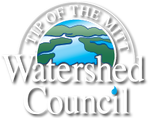Description:
The Crooked River is about 10 km long and connects Crooked Lake with Burt Lake. The river channel is dredged to provide recreational boating access between the two lakes. A lock and dam operated by the Army Corps of Engineers is located in the village of Alanson near the river’s outlet from Crooked Lake. It is used primarily to regulate the water level of Crooked Lake. The average annual discharge of the Crooked River is 3.8 cms (133 cfs). Several small streams discharge to the river in the vicinity of Alanson.
Most of the Crooked River’s Watershed is forested or grasslands except for the village of Alanson, and small farm plots north of Alanson. The village of Alanson is serviced by a sanitary sewer, while a small residential area along the river, known locally as Devil’s Elbow, relies on on-site disposal methods.
Some agricultural land exists within the watershed, but it is primarily in hay, with very little land devoted to row crops. Soils under row crops are generally subject to more erosion than soils under grass and hay. The agricultural land is separated from the river by extensive forested areas. The topography of the watershed is gently rolling, with level wetland areas adjacent to the river.
The soils of the Crooked River Watershed are wetland soils of the Carbondale-Tawas-Roscommon Association series. Beyond the river bottom wetlands lies a zone of nearly level, well-drained sandy soils of the East Lake-Blue Lake-Kalkaska Association soils. In some areas, poorly-drained sandy to loamy soils of the Thomas-Brevort-Iosco Association lie between the wetland soils and those of the East Lake-Blue Lake-Kalkaska Association. The upland soils areas are well-drained sandy soils of the Blue Lake-Leelanau Association.
The Crooked River is an integral part of Michigan’s historic Inland Waterway which connects Lake Huron to Crooked Lake near Little Traverse Bay on Lake Michigan in Emmet County. The Inland Waterway was used by the Native Americans and trappers as a fast route across northern Michigan instead of the longer, more dangerous passage through the Straits of Mackinac. Today, the Inland Waterway provides recreational boaters with over 40 miles of navigable waters, plus direct access to four of Michigan’s most beautiful and popular lakes.
Additional Resources:
| Title | Link |
|---|---|
| Comprehensive Water Quality Monitoring (CWQM) |
Videos
Crooked River – Cooking Oil Spill
Due to a traffic accident on June 11, 2013, nearly 2,500 pounds of used vegetable oil spilled in to the Crooked River via a nearby storm drain on US 31, south of M-68 in Alanson, Michigan. This video highlights the contamination that occurred.
Insert You Tube Video

